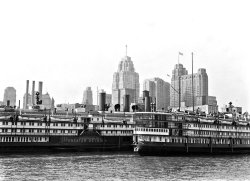
MAY CONTAIN NUTS

Search Shorpy
SHORPY ART

Framed or unframed, desk size to sofa size, printed by us in Arizona and Alabama since 2007. Explore now.
Join and Share
Ad-Free Shorpy
Shorpy is funded by you. Patreon contributors get an ad-free experience.
Learn more.

Recent comments
- Indiana Harbor Belt abides
- Freezing haze
- Corrections (for those who care)
- C&NW at Nelson
- Fallen Flags
- A dangerous job made worse
- Water Stop
- Passenger trains have right of way over freights?
- Coal
- Never ceases to amaze me.
- Still chuggin' (in model form)
- Great shot
- Westerly Breeze
- For the men, a trapeze
- Tickled
- Sense of loneliness ...
- 2 cents
- Charm City
- What an Outrage
- Brighton Park
- Catenary Supports
- Just a Little Before I was Born
- Afternoon normal
- The Flat Iron Cafe survives
- Aging in Place
- Raise your hand
- Good and Bad
- Oh, the 70's
- Nooooooi
- The aluminum tubing
Member Photos
The Shorpy
Print Emporium
Print Emporium
Search Shorpy
Search results -- 30 results per page
- Dream Sink: 1955
- May 3, 1955. "Model kitchen in Chicago showroom. Advertisement for Crane fixtures." Presenting, if not the ... Posted by Dave - 04/02/2014 - 12:15pm -
![Dream Sink: 1955 May 3, 1955. "Model kitchen in Chicago showroom. Advertisement for Crane fixtures." Presenting, if not the Kitchen of Tomorrow, at least the Breakfast Nook of Next Wednesday. Photo by Bill Hedrich, Hedrich-Blessing Studio. New York World-Telegram and Sun Newspaper Photograph Collection. View full size.
Modern kitchens aren't as modern as I thoughtThere's very little in this kitchen that gives away its age, mainly the seating and the flooring, and of course the black and whiteness of the photo. Even big free standing fridges are still popular in these days of integrated appliances (in the UK at least).
The inset cupboards below the sinks (there's another at the left) look a little strange, but are practical for getting you close to the sink. Is that a washing machine to the left of the sink?
[It's a dishwasher. - Dave]
Accurate enoughOther than the style of the fixtures, this looks a lot like a modern kitchen. Oh, and I guess a modern kitchen would have an island.
[Esthetically speaking, this was near the end of the line for the antiseptic, laboratory-like kitchens popular in the 1930s and '40s. The enameled steel cabinets seen here were also on the way out. - Dave]
Clever!Love the enameled radiator grate to cover the pesky gap behind the old frigidaire.
That WindowShows a feature I like to use: the 'sill' is down to the top of the back splash. Or, I make the sill at the same level as the counter top. Either way, you get a wonderful view while working at the sink.
DurableAn apartment I rented in college had these exact cabinets - down to the winged circle emblem on the dishwasher to the left of the sink. They were in surprisingly good shape in the 80's, and I wouldn't be surprised if they're still there today.
I need this nookIn fact, I like this whole kitchen, in particular, the arrangement of the shelf over the double-drainboard sink. I wish they noted the colors.
WowI find it hard to believe this kitchen was state of the art in 1955, but I was only five then so what do I know.
However it's still very classic in its design and my current kitchen cabinets look very similar to these, right down to the draw pulls.
I love it!Except for the metal cabinets. Yuck. You can see there is already a dent on the end of the ones on the right. Other than that I would love to have this exact set-up right now. I'm going to end up needing to use a wheelchair due to a birth defect and this would be fantastic for someone in one. I can see me rolling right up to the nook with my family. I'd even take the old style fridge.
(The Gallery, Kitchens etc.)](https://www.shorpy.com/files/images/SHORPY_09151u.thumbnail.jpg)
- Standard Automotive: 1926
- ... of the million dollar automotive industries show in Chicago.
He is survived by his wife, Phyllis O'Hara Stewart. A service ... Posted by Dave - 08/07/2012 - 9:39pm -
![Standard Automotive: 1926 Washington, D.C., circa 1926. "Standard Automotive Supply Co., 14th & S streets N.W." We've seen the interior here. National Photo Co. View full size.
Call boxesOk, Sorry if this has been explained to death, but I need clarification. The box on the right looks like a policeman's phone box, and if that's true, what's the other box for? A fire alarm?
Also The hanging weight for the fire escape in between the two boxes just brought back a bunch of memories. We had one old escape like that, and we used to swing on them as a kid. That's probably why you don't see them set up like that anymore.
[The box on the left is marked "Police Telegraph." Similar boxes made by Gamewell are shown below. The box with the light looks like a fire call box. Washington also had similar police call boxes. According to a 1925 article in the Washington Post, the first fire alarm telegraphs in the District were installed in 1864, then replaced in 1875 by a Gamewell system that was updated in 1909. By 1925 the number of Gamewell boxes was 825. "Every fire-alarm box located on the street is equipped with a red light that burns continuously, making it conspicuous in emergencies for the man on the street."
The article goes on to note that the police call boxes in Precincts 12 and 1 through 8 were maintained by the telephone company, while call boxes in other precincts "are the old Gamewell type." Details on operation of the police telegraph boxes can be found here. - Dave]
1800 14th Street NWThe building is still there, amazingly preserved. Although its neighbors on 14th are gone. It's right across the street from Crosstown Auto Supply, whose building is also still with us.
View Larger Map
Boston telegraph alarmsI was amazed to find that Boston (among others) still maintains a fire alarm telegraph call box system.
Frank G. Stewart
Stewart, Auto Supply Head, Dies
Frank Gregory Stewart, who was in the automotive industry here for more than a half century, died of a heart attack yesterday at his home, 1701 Holly st. nw. He was president of Standard Automotive Supply Co. and Stewart Manufacturing Co. and a member of numerous professional groups.
Mr. Stewart was born 65 years ago in Ohiopyle, Pa. He studied engineering at Maryland University and Stevens Institute of Technology, in Hoboken, N.J. He came to Washington before World War I and was granted the Reo automobile agency for the district.
Mr. Stewart organized the Standard Automotive Supply Co., 1835 14th st. nw., shortly after World War I. The firm was incorporated in the late 1920s and Mr. Stewart served as president until his death. The Stewart Manufacturing Co., an affiliate of Standard Automotive, was founded shortly after World War II. Products manufactured by the company include several of Mr. Stewart's inventions, including a screw and nut locator and an automotive stethoscope for testing engines.
Mr. Stewart was the founder and first president of the local chapter of the Automobile Oldtimers, a national organization. He recently was made an honorary member of the Antique Automobile Club of America. He also belonged to the Automotive Engineers, Society of American Military Engineers, Washington Board of Trade, Washington Automotive Trade Association, Navy League, and George Washington Post of the American Legion. In 1954 Mr. Stewart was chairman of the million dollar automotive industries show in Chicago.
He is survived by his wife, Phyllis O'Hara Stewart. A service well be held at 10 a.m. Friday at Hines funeral home, 2901 14th st. nw. A Navy veteran of World War I, Stewart will be buried in Arlington Cemetery.
Washington Post, Sep 11, 1957
P.A.. LomaxThe reflection in the window indicates that P.A. Lomax was the undertaker across the street.
Cast iron architecturalQuite a lot of cast iron skirting and grates have been used in the display window support in these buildings. I wonder if they are original to the building or were added later? Cast iron ornament and even entire building facades came into popularity before the Civil War and were manufactured into the 20th century; it was cheaper and more durable than the stonework it sometimes imitated, and of course, it allowed for intricate scroll and openwork that would have been nearly impossible in masonry or wood. A great deal survives into the 21st century where the buildings have not been razed.
(The Gallery, Cars, Trucks, Buses, D.C., Natl Photo, Stores & Markets)](https://www.shorpy.com/files/images/32322u1.thumbnail.jpg)
- America's First Car: 1920
- ... automobiles (along with several prototypes), won a race in Chicago in 1895, and also the inaugural London to Brighton Run in 1896.
... Posted by Dave - 04/26/2011 - 1:23pm -
![America's First Car: 1920 "Wayne Smith Auto Co., front." Mr. Smith went to Washington, and built this dealership at the corner of M and 22nd. A street view of the building shortly after its completion in 1920. National Photo Company glass negative. View full size.
HaynesNot only America's finest, but also its first.
First with the FinestDoesn't it say "America's First Car," not "Finest"?
[Oops. Fixed! - Dave]
Wayne's Haynes!Sorry, I couldn't resist the rhyme!
Haynes was no cheapieThe 1920 Haynes 12-cylinder, 4-door roadster was listed at $3250. That's more than 37,000 2011 dollars. Wayne Smith would have had to look for another line in a few years, though, since Haynes went out of business in 1924.
Just another day at work.There is a man bent over in the front office (window on the left).
Auto-BiographThis building later became the Biograph theater, showing old movies and art films. Went out of business with the advent of the VCR.
Not The BiographWhile similar in appearance this is not the building that became the Biograph Theater which is actually about 6 blocks west on M street from where this building once stood.
America's First Car? Not!I have never before seen Haynes as being credited with being America's first car.
This honor goes to Duryea who by the close of 1896 had produced 13 automobiles (along with several prototypes), won a race in Chicago in 1895, and also the inaugural London to Brighton Run in 1896.
According to wikipedia, Haynes only produced five cars in 1898 (the first year of production shown).
The first Duryea is from 1892/1893 while the first Haynes is from 1894.
(The Gallery, Cars, Trucks, Buses, D.C., Natl Photo)](https://www.shorpy.com/files/images/29316u.thumbnail.jpg)
- Iron Dragon: 1943
- ... 1943. "On the Atchison, Topeka & Santa Fe between Chicago and Chillicothe, Illinois." Another of the many photos by Jack Delano documenting his trip on a freight train from Chicago to California. View full size.
For those of us in the North ... Posted by Dave - 11/24/2013 - 8:35am -
![Iron Dragon: 1943 March 1943. "On the Atchison, Topeka & Santa Fe between Chicago and Chillicothe, Illinois." Another of the many photos by Jack Delano documenting his trip on a freight train from Chicago to California. View full size.
For those of us in the North CountryIt's a beautiful picture, but I'm going to be looking at landscapes like this for the next five months.
Wonderful, Jack!I just can not get enough of these terrific train pictures.
Which reminds me -- anything ever from Lucius Beebe?
[The occasional order for caviar and Champagne. - Dave]
Ahhh, that's Lucius alright..... from ''The Pump Room''?
#3259was 2-8-2 stationed at Chillicothe that met its fate in 1952. You may have driven around in a car with parts made from this beauty.
Old Tea kettlesSP&S #700 is getting eready to make some runs the next few weekends as the HOLIDAY EXPRESS, here in Portland, Oregon.
Along with SP #4449, SP&S #770 is one of two historic steam engines tha operate out of Portland, with a third one currently being restored to running condition.
There is nothing like the sound of a Steam train and whistle.
Is she "carrying green?"I'm referring to the flags that can be seen on either side atop the smoke box. Very difficult to tell in an old black&white photo. They may be very dirty white ones, however.
Green signified "extra section(s) to follow," meaning the train was long enough that it was divided into more than one train. White flags meant it was "running extra" as an unscheduled train not listed on the timetable.
Considering the date, March 1943, at the height of WWII, either designation was possible. The railroads were doing yoeman service hauling troops and freight for the war effort!
(The Gallery, Jack Delano, Railroads)](https://www.shorpy.com/files/images/SHORPY_8d26327a.thumbnail.jpg)
- Throwing the Switch: 1929
- ... the transmitter sites, perhaps across country to New York, Chicago and the West Coast.
There is one knob that seems to be labelled ... Posted by Dave - 08/07/2012 - 10:27am -
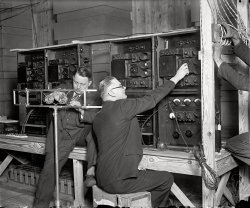
- Open-Air School: 1917
- ... training class at the Franklin summer open-air school in Chicago." The open-air movement, which started in 1908 and ran through the ... powers of fresh air. Photograph by Burke & Atwell, Chicago. Elizabeth McCormick Memorial Fund. View full size.
So are the ... Posted by Dave - 08/19/2020 - 7:04pm -
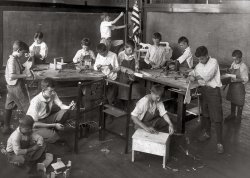
- After Every Meal: 1928
- ... brother orphaned. Cusack was raised by relatives in Chicago, where he received his education and learned how to paint, a skill that ... own sign painting business, the Thomas Cusack Company, in Chicago, Illinois, making him one of the pioneers in the field of outdoor ... Posted by Dave - 02/28/2018 - 5:59am -
![After Every Meal: 1928 Fredericksburg, Virginia, circa 1928. "John Paul Jones House, Main Street." Home not only of the Revolutionary War naval commander but also of the Sanitary Grocery. 8x10 acetate negative by Frances Benjamin Johnston. View full size.
I walk past this house almost every weekI live in Fredericksburg, this is a well known landmark. But it actually belonged to J.P. Jones' brother. J.P. would visit his brother and stay there from time to time. It’s a bit more plain looking today, but still there.
A survivor
These short naps are greatfor both old men and barefooted babies. One wonders what the rest of the story is that would have created this scene.
Chases Dirt
And a place to lay your head.Hitchin' his wagon to the post. Looks like a long haul home with Mom.
[That's a scale. -tterrace]
Good eye tterrace. On closer examination it is a scale. Still a good place to rest your head.
[There was one on my grandpa's ranch when I was a wee ’un. I'd watch my father weighing me on it and I couldn't figure out how it worked except by magic. -tterrace]
The P K stands for Philip Knight Wrigley, I had to find out.
Historic Highs and LowsThe historic plaque remains, but has been lowered from its lofty height, to a level readable by mere mortals.
I wonder what the plaque says.
Thar's Gold In Them Thar SignsThomas Cusack (October 5, 1858 in Kilrush, County Clare, Ireland – November 19, 1926 in Oak Park, Illinois) was a pioneer and entrepreneur in the outdoor advertising industry and a politician, serving as a Democratic U.S. Representative from Illinois' 4th District from 1899 to 1901.
Cusack emigrated with his family from Ireland to New York City in 1861 when he was a young boy. Shortly after the move, his parents died, leaving him and his younger brother orphaned. Cusack was raised by relatives in Chicago, where he received his education and learned how to paint, a skill that ultimately made him a very wealthy man. At the age of 17, Cusack established his own sign painting business, the Thomas Cusack Company, in Chicago, Illinois, making him one of the pioneers in the field of outdoor advertising. The business soon grew to be very profitable, leasing over 100,000 billboards and advertising spaces and turning Cusack into a prosperous and influential Chicagoan.
More Bio
More Billboards
(The Gallery, F.B. Johnston, Stores & Markets)](https://www.shorpy.com/files/images/SHORPY-05956a.thumbnail.jpg)
- Tucked In: 1905
- ... Below is a photo I took of the E. M. Ford at South Chicago in 1962. I was just a kid.
Backseat Driver Out of curiosity, ... Posted by Dave - 08/08/2012 - 7:11pm -
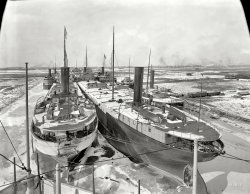
- Dinner Dance: 1950
- Harmony Club of Chicago, 28th Annual Dinner Dance, March 11,1950 at the Stevens Hotel, Chicago. Photo by Burke & Dean Photo, Chicago. I did a little research and discovered that the Harmony Club of ... Posted by jonnyfixit - 08/31/2012 - 8:47pm -
![Dinner Dance: 1950 Harmony Club of Chicago, 28th Annual Dinner Dance, March 11,1950 at the Stevens Hotel, Chicago. Photo by Burke & Dean Photo, Chicago. I did a little research and discovered that the Harmony Club of Chicago still exists and their mission is "to promote cooperation in the electrical trade." In particular, they are associated with IBEW Local 134.
This is a panoramic photo. I have been at similar events, and the way it works is: A photographer with a special camera comes in and offers to take a panoramic shot of the whole crowd, and he takes orders for copies afterwards. He pans the camera across the crowd slowly and everyone tries to move as little as possible. It takes several seconds to pan across the crowd. This is a scan of a 12x20 photo I bought in an antique store recently. View full size.
No wayThere's no way in the world so many people would (or could, looking at some of the wine carafes in the room) hold absolutely still while a camera panned across the room. This shot had to have been taken as one wide photo by a camera with a panoramic lens. Panning a still camera creates a "wiped" or blurred image.
[These types of photographs were popular enough that the cameras used were commonly called "banquet cameras," large-format view cameras that had a motor-driven rotating lens, hence the need for the crowd to remain still for the duration of the exposure. They used sheet film that ranged in size up to 12x20 inches, exactly the size of the photo that jonnyfixit scanned; so this is a contact print made from such a negative. - tterrace]
Well, once again my place has had me put in it. However, I repeat my belief there was no way that big crowd and those musicians stayed perfectly motionless for such a photo. Impossible.
ThanksTterrace, thanks for the details on how the camera worked. Both times when I was in a convention where they took our picture with a banquet camera, the photographer gave a brief explanation beforehand but I don't remember him going into detail about the rotating lens or that kind of detail, so I never knew how it moved or what moved. I don't think I was close enough to get a good look at the camera, other than it was Big! It was in the early 1990s that those pictures took place. I bought copies of both of them. I wish I knew where they went. Ours were in color. Hope I find them one of these days.
-Jonnyfixit
Banquet Camerawas used, and not a moving lens Panoram or Circuit camera.
A careful look at the distortion seen in the faces near the edges and corners shows that this was shot with a rather conventional 12x20 Banquet Camera, as was common in the day. These cameras used a somewhat wide angle lens and a wide aspect ratio film/plate format.
The Panoram (moving lens with fixed position curved film) and Cirkut (whole camera rotated during exposure) do not produce this type of distortion. They do produce a different alteration in the image. The Kodak Panoram swung the lens and moved a traveling slit across the pre-curved fixed position film. The Cirkut cameras rotated as a unit with the film moving past a slit.
(ShorpyBlog, Member Gallery)](https://www.shorpy.com/files/images/harmony1_stitch-sepia-25pct.thumbnail.jpg)
- Pilot Project: 1938
- ... is made—by air. A Government official is in Chicago. Urgent matters of state call him to Washington. He is there in less ... Posted by Dave - 12/15/2013 - 11:14pm -
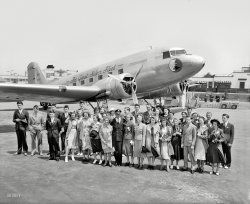
- School Zone: 1941
- April 1941. "Scene in Negro section of Chicago, Illinois." Medium format negative by Russell Lee for the Farm Security Administration. View full size.
(The Gallery, Chicago, Russell Lee) ... Posted by Dave - 09/21/2018 - 7:30pm -
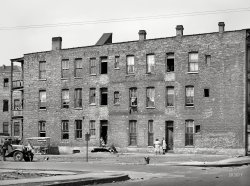
- Top 20 Images of 2007
- ... reads)
No. 10: Carina Nebula (20,935 reads)
No. 11: Chicago & North Western Locomotive Shops, 1942 (20,750 reads)
No. 12: ... Posted by Dave - 01/01/2008 - 8:09pm -
![Top 20 Images of 2007 Welcome to the first annual Shorpy Top 20 New Year's Eve Image Countdown, where we recap the year's most popular posts based on number of reads. You can keep track as the evening progresses on the grid below. (We'll get to the Top 10 starting around 11 p.m. Eastern Time.) And the No. 1 post of 2007, with 104,800 reads: A screen grab of . . . The Beaver Letter! Whew. Well that was fun but exhausting. Thanks to everyone for making this a super first year for Shorpy!
The ranking grid and read numbers reflect picture standings as of 4 p.m. Eastern time on December 31, 2007. View counts rounded to the nearest whatever.
No. 1: The Beaver Letter, 1958 (104,800 reads)
No. 2: Pie Town Dugout, 1940 (89,800 reads)
No. 3: Weeki Wachee Mermaid, 1947 (85,500 reads)
No. 4: Brooklyn Pin Boys, 1910 (84,700 reads)
No. 5: Inter-City Beauties, 1927 (73,200 reads)
No. 6: Pageant of Pulchritude II, 1928 (37,300 reads)
No. 7: Beach Policeman, 1922 (37,100 reads)
No. 8: Mr. 535-07-5248 and Wife, 1939 (36,800 reads)
No. 9: Custer Car, 1924 (24,700 reads)
No. 10: Carina Nebula (20,935 reads)
No. 11: Chicago & North Western Locomotive Shops, 1942 (20,750 reads)
No. 12: 1951 Oldsmobile Final Assembly (18,290 reads)
No. 13: Flying Fortress, 1942 (18,270 reads)
No. 14: Pageant of Pulchritude, 1928 (18,200 reads)
No. 15: The Virtual Buick, 1953 (17,300 reads)
No. 16: Carnival Ride From Hell, 1911 (16,600 reads)
No. 17: Hi-Fi Boombox, 1954 (15,000 reads)
No. 18: Bathing Girl Parade, 1920 (14,900 reads)
No. 19: Migrant Mother, 1936 (14,800 reads)
No. 20: Manhattan skyline in 1901 (14,500 reads)
The Countdown...What a great idea! This is a good way to give the most popular images another viewing, and the grid format with the numbers makes a nice display.
As I write this, we're only at number 19 but the number for views is amazing -- nearly 15,000! It will be interesting to see all twenty, and see if we can generalize about what kind of photographs tend to get the most views here.
Happy New Year, one and all!
[Thanks! I'm so excited my party hat keeps falling into the champagne fountain! - Dave]
PIE TOWN! PIE TOWN! PIE TOWN!I myself wonder why some of these were so popular. Give me a good old Pie Town picture any day. I hope there is a picture from Pie Town in the top 20. Is there Dave? Huh? Is there?
[Mayyybe. Maybe not. Only one way to find out! - Dave]
Top 20Great Idea, I wonder if a "Beaver" shows up or an out of this world photo?
[The envelopes are sealed. No holding them up to the light! - Dave]
Lovin' the countdownNow I'm kinda sorry I'm going out tonight! I'll check back to see how it all turns out as soon as I come home. Happy New Year, Dave, and thanks for all the great Shorpiness!
[Thanks Mattie! Too bad we can't be Tivo'd. - Dave]
Pie Town at No. 2Not bad, not bad at all. There's just something about a place called Pie Town.
[Yep, I was very happy to see that. Although it's a little sad that Shorpy himself couldn't be No. 1 (or even have a spot in the Top 20 ... although if you count his three photos as one, he got close to 20,000 views). - Dave]
The Beaver Letter!Okay, now I can go out for the evening! This was a blast - hope you'll do it again next year!
[Yes, well. Thanks. Hope we're here next year! Which is actually this year. Happy 2008, everyone. - Dave]
Wonderful...Such a fine collection for Shorpy's first annual Top Twenty photos.
Thank you Dave, for all that you do.
Happy New Year everyone, may we all be be blessed with health, happiness, and prosperity in 2008.
(ShorpyBlog, New Year)](https://www.shorpy.com/files/images/girl.thumbnail.jpg)
- Marcella and Viola: 1943
- ... Iowa. "Marcella Hart and Viola Sievers, wipers for the Chicago & North Western Railroad, cleaning one of the giant H-class ... Posted by Dave - 08/04/2012 - 11:05pm -
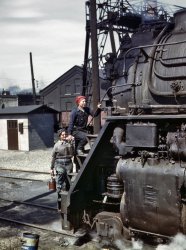
- Ray Schalk: 1924
- "Schalk, Chicago, 1924." View full size. National Photo Company Collection.
... and fan of the "deadball" era of baseball and the Chicago White Sox during the early years of the past century.
Cooper's ... Posted by Dave - 03/07/2008 - 5:16pm -
![Ray Schalk: 1924 "Schalk, Chicago, 1924." View full size. National Photo Company Collection.
BaseballI just can't wait for the season to begin. Thanks for posting these classic pics of the great game.
RayThere's a soon-to-be published biography on Ray Schalk coming from Brian Cooper, a journalist and fan of the "deadball" era of baseball and the Chicago White Sox during the early years of the past century.
Cooper's biography of White Sox pitcher (and spitball artist) Red Faber is a wonderful evocation of that era. Schalk caught a majority of Faber's 254 career winning games.
[It'll be interesting to see what they use for cover art. - Dave]
On the Topic of BaseballTonight will be opening night for the Washington Nationals in their brand new ballpark ... took the virtual tour at their official website ... incredible place.
Also... using photos from the National Photo Company Archives at the LOC ... have a "baseball project up at youtube.com, in time for the opening of the 2008 season ...
http://www.youtube.com/watch?v=w_idXc_3rus
even includes a bit of Harry Carey, and Abbott and Costello
Dale
BaseballDale, it's excellent - thank you
Opening DayAnother great one, Dale. Thank you
(The Gallery, Natl Photo, Sports)](https://www.shorpy.com/files/images/11567u_0.thumbnail.jpg)
- Air Travel: 1902
- Iowa circa 1902. "Chicago & North Western Railway -- steel viaduct over Des Moines River." ... Posted by Dave - 07/17/2012 - 10:38pm -
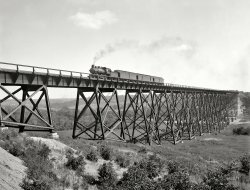
- Adrian C. Anson: 1887
- ... A baseball card for Adrian C. Anson, first baseman for the Chicago White Stockings. Issued by Allen & Ginter Company, 1887. View ... Posted by Ken - 12/04/2007 - 12:20am -
![Adrian C. Anson: 1887 A baseball card for Adrian C. Anson, first baseman for the Chicago White Stockings. Issued by Allen & Ginter Company, 1887. View full size
Another look at "Cap" Anson."Cap" Anson was the was the 1st member of the 3000 hit club.
Origin of cardsI don't know how commonly known this is, but this photo illustrates the fact that baseball cards were originally introduced in cigarette packs in order to keep the cigarettes from bending over. When they later started getting popular with kids they were packaged with bubble gum.
On a totally different note, this illustration makes the guy look like he's in "Night of the Batting Dead."
"How do I get to the Susquehanna Hat Company?"
Blowing Up A Baseball Card To The Size Of A PosterBy my estimation, the "Full Image" version of this is approximately 30 times the size of what it's supposed to be, which would partially account for the somewhat pixilated effect.
[And maybe even pixelated. - Dave]
BatIt's interesting to view the evolution of baseball equipment over the decades, particularly (as this card shows) bats. Today's lumber has much more "meat" at the hittin' end, with a tapered handle that probably allows for higher swing speeds. Could this be due to better wood selection, lathing and curing techniques by the folks down there in Louisville? The lumber swung by the hitters of today's game make Cap's bat look like a fat stick.
Ginter = Richmond industrialistLewis Ginter:
http://en.wikipedia.org/wiki/Hollywood_Cemetery
http://www.lewisginterrecreationassoc.org/history.html
Major Lewis Ginter (1824 - October 1, 1897) was a prominent businessman, army officer, and philanthropist in Richmond, Virginia
Of Dutch ancestry, he was born Lewis Guenther in New York City, New York, he moved to Richmond, Virginia in 1842. Ginter had a number of careers, arguably making and losing a fortune three times. Ginter amassed a great fortune in the tobacco industry via new technology for rolling cigarettes. He used this massive fortune to act as a philanthropist and for the development of civic and business interests in Richmond. He developed the neighborhood Ginter Park and brought the Union Theological Seminary there. His niece Grace Arents continued his philanthropy, spurring the development of St. Andrew's School, the Instructional Visiting Nurse Association and the Lewis Ginter Botanical Garden at her home Bloemendaal.
He served with the Confederate States Army during the American Civil War, rising to rank of Major. His residence Ginter House sits on the Monroe Park campus of Virginia Commonwealth University.
Hired on to the John Allen & Co, he became a partner of the Allen and Ginter tobacco company that ushered in a number of innovations including cigarette cards and the use of local Virginia tobacco. In 1890 Ginter's company joined forces with James B. Duke to form the American Tobacco Co..
Ginter also commissioned the design and construction of the luxurious Jefferson Hotel Richmond, which opened in 1895.
Anson helped erect the pro baseball color barrierhttp://www.capanson.com/chapter4.html
Cap Anson was (common for the era, even in his native Iowa) a bigot. His racial attitudes were stronger than most, however, and he led efforts to exclude blacks from professional baseball.
Note that Jackie Robinson was NOT the first black to play in the major leagues -- both Fleet and Welday Walker played in 1884 before the color barrier limited baseball to the (ahem) melanin-impaired.
(Sports)](https://www.shorpy.com/files/images/0002fu.thumbnail.jpg)
- Union Traction: 1907
- ... so fast. About the last old interurban still under wire is Chicago, South Shore and South Bend RR.
Is that a mail delivery trolley? ... Posted by Dave - 08/01/2012 - 1:41pm -
![Union Traction: 1907 Indianapolis, Indiana, circa 1907. "Union Traction Co. -- Union Terminal Building." 8x10 inch glass negative, Detroit Publishing Co. View full size.
Union Terminal interurbansThis was the largest interurban terminal in the world. Indianapolis was the epicenter of the traction industry, with routes leaving the city in virtually every direction, with all the lines terminating here.
An interurban was not a streetcar, but a long distance, heavy duty electric railway running between distant cities. They ran limited express, milk run locals, some sleepers and diners and even carload freight trains.
Union Traction merged with a number of other properties to form Indiana Railroad. The tax-supported highways killed the IR off in the 1930's.
Many cities had at least one or two interurban lines, and with few exceptions were all gone by Pearl Harbor. Few American industries rose so high and fell so far so fast. About the last old interurban still under wire is Chicago, South Shore and South Bend RR.
Is that a mail delivery trolley?Or an early UPS truck in the barn?
Pretty cool, whatever it is.
Express carThey sure do seem to be loading express parcels, likely from the Terminal's basement. Note the elevator is up.
But I don't think this car was going any great distance. Those four wheels would preclude making any time on a high speed run. Probably making local deliveries around town.
Interurbans ran parcel express cars, Railway Post Office cars, and as I said earlier, hauled their own or steam railroad freight cars on some lines.
In Baltimore was an express company running their own cars on the city car lines for a time; Indianapolis may have had a similar outfit. Someone with more knowledge of I'polis might tell us.
Market & IllinoisWest Market and North Illinois Street. The building in the background is the Indiana Statehouse.
View Larger Map
"The standard of perfection"Long before Cadillac adopted that motto!
[I think Cadillac's was "Standard of the World." - Dave]
Changing modes of transportSomewhat later, this was the Greyhound Terminal. See Terminal Lunch:1943 and Indianapolis: 1943.
(The Gallery, DPC, Indianapolis, Railroads, Streetcars)](https://www.shorpy.com/files/images/4a22244a.thumbnail.jpg)
- Cherry Street Bridge: 1909
- ... at Detroit by J. H. Jones for the Prindiville interests of Chicago and named for a Chicago investor allied with Prindiville. It served the lumber trade until ... Posted by Dave - 09/18/2016 - 4:13pm -
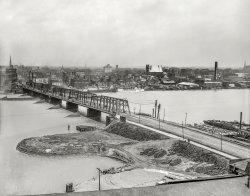
- Home Team: 1924
- ... pitcher might have been brief, but he won 62 games for the Chicago White Sox from 1904-06. In '06, he pitched twice in the Sox' World ... Posted by Dave - 05/10/2013 - 10:18am -

- Gloomy Gippers: 1950
- ... of locker room depression since... Last night with the Chicago Cubs.
Really? I'd be depressed too if I had to sit on the floor, ... Posted by Dave - 10/26/2016 - 2:41pm -
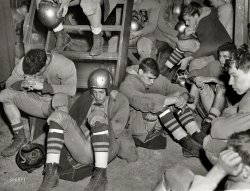
- Chenoa Depot: 1905
- ... limits ahead. Two railroads went through town, the Chicago and Alton (C&A), and the Toledo Peoria and Western (TP&W). The ... Posted by Dave - 08/21/2012 - 12:39pm -
![Chenoa Depot: 1905 Circa 1905. "Station & buildings at Chenoa, Illinois." Plus: circus posters! 8x10 inch dry plate glass negative, Detroit Publishing Company. View full size.
Changes in a few yearsHere's a post card found online, dated c. 1911, that shows the station from another side. It looks to be the wrong size at first glance, but refer back to the Shorpy photo and note how oversize the doors and windows are compared to the man checking out the postings by the door.
A row of trees have been planted. The express company building appears to be moved or removed by about 1911.
Diamonds/crossings and new track are in place right by the station -- things are getting busy in Chenoa! So here are the two railroads mentioned earlier, resulting in the station being called a union depot in the post card inscription.
In the 1911 picture, I wonder how long that (electric?) line lasted hanging over the tracks? It had to have been blasted by stack exhaust from engines that passed under it.
Circus stars leave townI see the trunk escape artists are waiting on the platform.
WaitingFor the 5:25 from Joliet.
OS ChenoaTo bad Bobby Troup didn’t roll Chenoa into his famous tune, “Route 66.“ Looks like a train departing after dropping off freight for the United States Express Company to handle. Train order board is at stop, most likely for the occupied block the departing train is in. My guess is that the smaller semaphore is a distant signal for the interlocking limits ahead. Two railroads went through town, the Chicago and Alton (C&A), and the Toledo Peoria and Western (TP&W). The TPW is still at it, owned by Rail America. I get a glimpse of their trains in Kentland, Indiana now and again while rambling on highway 41. The old C&A is now part of the Union Pacific. Can only wonder which main is pictured.
Graffiti or signage?Look to the right at that smaller structure. I think I see a prancing horse painted on a panel.
[That's a seal on one of the circus posters mentioned in the caption. - Dave]
When railroads interesctYou end up with beautiful little Midwest towns like this. Even today it's hard to find towns this small except in the middle of nowhere whose form and function derived from being on a rail line. It's still a small beautiful town.
Passing ByThis past March, my wife and I drove past Chenoa on I-55. We were returning to the Bull City from a Shorpy-inspired visit to Dwight. I guess next time we'll stop in Chenoa.
(The Gallery, DPC, Railroads)](https://www.shorpy.com/files/images/4a20205a.thumbnail.jpg)
- Piano Prodigy: 1922
- ... mysteriously in 1959 According to an article in the Chicago Tribune, she was found dead under water in a bathtub at the Drake Hotel ... Posted by Dave - 03/08/2013 - 5:30am -
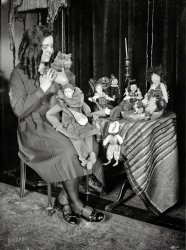
- Man of Letter: 1904
- ... Trinidad Naval Air base and the Republic Steel plant in Chicago. It also worked on the West Side Express Highway in New York.
... Posted by Dave - 01/23/2020 - 9:31am -
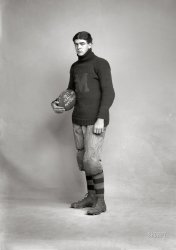
- Deplaning at Oshkosh: 1952
- ...
One trip in the States, 1956, we went from New York to Chicago on Eastern Airlines. Puddle jumper. Lots of takeoffs and landings. ... Posted by K. McCool - 08/02/2018 - 7:52pm -
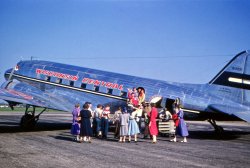
- Clovis Man: 1943
- ... AT&SF merged with Burlington Northern (formed when the Chicago Burlington and Quincy merged with the Great Northern) to form the ... Posted by Dave - 06/17/2009 - 8:36pm -
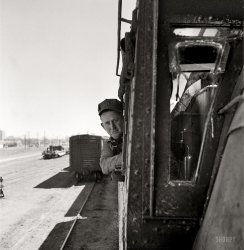
- The Gospel Wagon: 1900
- ... Erie; Pennsylvania; Buffalo Rochester and Pittsburgh; Chicago and Northwestern, and Nickel Plate. There may be more, but they're too ... Posted by Dave - 09/16/2017 - 9:43am -
![The Gospel Wagon: 1900 Buffalo, N.Y., circa 1900. "Ellicott Square Building." At the time of its completion 1896, the largest office building in the world. Our title for this post comes from lower down (and higher up). 8x10 inch glass negative. View full size.
I like the Gospel Wagon idea..At least there not out knocking on your door during the Pittsburgh Steeler games.
Progressive?What does one sell in a "progressive" store?
["Progressive" as in the sense of "modern," as in this article, which seems unintentionally prescient. -tterrace]
Phoenix Reflected The Phoenix Brewery, (a very popular name used through out the country), operated in Buffalo from 1887 to 1920, closed for prohibition from 1920 to 1934, operated again from 1934 to final closing in 1957. The title refers to the "BEER" reflection in one of the store windows across the street to the left.
Signs of the TimesThere are at least five separate railroad ticket offices in the building: Erie; Pennsylvania; Buffalo Rochester and Pittsburgh; Chicago and Northwestern, and Nickel Plate. There may be more, but they're too fuzzy to read. Also like the interesting phonograph store selling Columbia and Edison cylinders and players (no they were not compatible).
Ministering On Main StreetThe Ellicott Square Building (283-309 Main Street) was completed in mid-1896 and still stands today. Six workmen died during the building's construction. Across the street was 304 Main, home to Palmer's Florist and the Albany Dental Parlor. “Sam. Welsh's Progressive Store” was the cigar store of brothers Samuel and Charles E. Welsh. They opened their 311 Main Street store in November of 1899, having previously operated the Progressive Cigar Store at 331 Main Street. Perhaps the Gospel Wagon Association thought that those buying cigars and phonographs needed to be exposed to something a little more “redeeming.”
Sidewalk Sign DesignI am interested if anyone knows the purpose of the signs placed along the sidewalks, which seem to be advertising above, and vertical bars of some sort below. Perhaps stops for public transportation, but why so many? And what are the bars for? A classic Shorpy mystery for me.
[A rare sight in early Shorpy street scenes: a bicycle rack, like the one in use here. -tterrace]
Future office of Wild Bill DonovanWhen this was taken, a local Buffalo teen named William Joseph Donovan was in St. Joseph's Collegiate Institute, with big dreams. He would enroll in Niagara University for two years before transferring to Columbia, where he received a B.A. and law degree. Returning to his hometown, "Wild Bill" went into private practice with Love & Keating in 464 Ellicott Square. He would remain there until he scratched the itch to form his own law firm in 1912. O'Brian, Hamlin, Donovan & Goodyear moved into the brand-new Iroquois Gas Building. Donovan's office grew dusty as he devoted more and more time to reawakening New York's militia and turning it, by 1917, into the "Fighting 69th" New York Infantry. As its colonel, Donovan became nationally famous, leading to a series of positions that would culminate as his appointment during World War II to begin the Office of Strategic Services - the forerunner of the CIA.
(The Gallery, Bicycles, Buffalo NY, DPC, Stores & Markets)](https://www.shorpy.com/files/images/SHORPY-4a29267a1.thumbnail.jpg)
- Rent-a-Book: 1940
- ... 1940: In an effort to generate more foot traffic in his Chicago camera store, my grandfather Edwin Shutan dedicated a section to a book ... Country Growth-August Derelth. This store was in downtown Chicago so most of their customers probably rode the L and read on their trips ... Posted by Shutan.com - 03/02/2018 - 9:51pm -
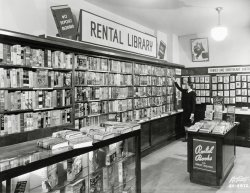
- How to Be Cool: 1912
- Matty McIntyre of the Chicago White Sox against a backdrop of sales pitches in 1912. View full ... (remember, this was the "dead ball" era). He played for Chicago in 1911 and 1912 which dates the picture. He died in 1920 at the age ... Posted by Dave - 09/08/2011 - 1:30pm -
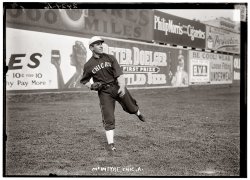
- Welcome D.U. Bathrick: 1946
- ... I made of a Michigan State Univ. library archive scan of a Chicago Sunday Tribune article from their November 5, 1939 edition.
Press. ... Posted by Dave - 04/19/2015 - 7:45pm -
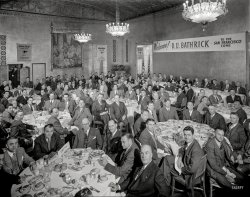
- Detroit tourism, 1930s
- ... to a small aircraft carrier during W.W.II and based in Chicago for pilot training. It was renamed the U.S.S. Sable.
Late to the ... US Navy in 1942 as the U.S.S. SABLE, which operated off Chicago alongside the U.S.S. Wolverine (formerly the Sea&Bee) as aircraft ... Posted by bhappel - 09/28/2009 - 11:09am -
